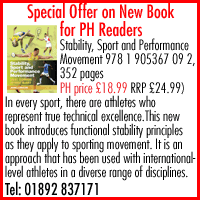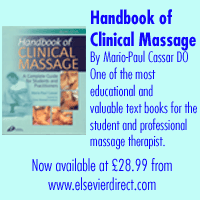Positive Health Online
Your Country

The Concise Book of Trigger Points: 2nd Edition
by Simeon Niel-Asher
listed in bodywork
In a similar vein to the first edition, this book is presented as a compact reference guide to trigger points and is aimed at the student/practitioners of Massage/ Bodywork, Physical Therapy, Physiotherapy, Osteopathy, Sports Therapy, and other health-related fields. The text deals with the physiological features of trigger points and some of the techniques which can be utilized in the treatment of these hypersensitive zones.
The first chapter offers a short revision of muscle physiology, the types of muscle fibres, the various shapes of muscles, the group action of muscles, the fascia and myofascia.
An overview of trigger points is given in Chapter 2. The author appropriately quotes Drs Janet Travell and David Simons (the originators of the trigger point theory) for the definition the basic description of trigger points that they presented in 1993. Some later evidence is also given (albeit brief), as well as the basic differentiation i.e. whether they are active, latent or a control group. The author then goes on to describe the physiology of these hyper-irritable localized spots (myofascial trigger points is another very commonly used term), which includes their correlation to acupuncture and acupressure points, the nutritional and biochemical factors, the trigger point formation and posture, fibromyalgia and the classification of trigger points. Signs and symptoms associated with trigger points are described as referred pain patterns, autonomic effects and physical findings.
Chapter 3 depicts the therapeutic procedures in the assessment and treatment of trigger points which naturally includes the very important palpatory evaluation of tissue dysfunction as well as the findings and symptoms. One of the techniques which can be used in the treatment of trigger points is the application of injections and dry needling. These procedures are concisely described in this section; however the author, rightly so, does not recommend them for the inexperienced manual therapy practitioner. This is followed by the primary form of treatment i.e. the 'spray and stretch' method, together with the equally important 'stretch and release' technique as well as various massage strokes. Muscle energy techniques such as Post-isometric relaxation and Reciprocal Inhibition and Positional Release Techniques are all included as part of the treatment. They are however explained only in brief with very poor illustrations to accompany the text. As this is a compact reference guide, it has to be assumed that the reader is already familiar with these methods and this section serves as a direct review.
Chapters 4 to 9 contain the core material of this book. The chapters are organized by regions of the body and muscle groups; each two-page spread features detailed colour illustrations of each major skeletal muscle. The accompanying text identifies the muscle's origin, insertion, action, and function. The colour illustrations are all very clear and, alongside the image of the muscle, each illustration depicts the location of the trigger point/s found in that particular muscle or muscle group. A trigger point often refers pain to an area which is within the same region or distant to it; sometimes it can even have an effect on an associated visceral organ. These are referred pain patterns and, besides the details already described, each illustration also portrays the referred pain pattern associated with that particular trigger point.
Indications for carrying a treatment on trigger points are listed and, as already mentioned, the presenting symptoms which can range from pain in a superficial fascia, muscular/skeletal tissue (arthritic changes, tennis elbow etc) to organ dysfunction and tenderness; they can also include conditions such as irritable bowel syndrome, headache and asthma. The author also includes a differential diagnosis of the presenting symptoms, a very sensible addition bearing in mind that awareness of pathological changes and a precautionary approach are essential for safe practice.
Following on, the author gives the modus operandi for addressing the trigger points. The various methods, namely dry needling, injections, 'spray and stretch' and 'trigger point release', are listed and the author indicates here which of these methods are recommended for the experienced practitioner, and those that are best carried out by the inexperienced therapist. Moreover the author suggests a course of action that the patient can follow to complement the benefits gained from the treatment. Line drawings of exercises which may form part of the recommendations are shown where applicable.
Chapter 10 is an additional chapter in this revised edition. In it the author presents some further theories on the physiology, formation, and treatment of trigger points.
Some of these ideas may be his rather than the recognized understanding, but they are interesting nonetheless. He proposes the Four New 'Laws' that can be applied to determine the where and how trigger points manifest. The theory is that:
(1) Trigger points tend to develop along 'mysofascial meridians' (involving myokinetic chains and sub-links); (2) That not all trigger points are equal and that some are even super trigger points (involving various neuro-receptors); (3) That trigger points warp sensory perception; (4) That trigger point release must be three-dimensional.
The last section of this chapter is titled 'Manual Therapy and Self-Help. It is rather amusing to note that there is no actual self help guidance, as the text (like the rest of the book) and instructions, are written with the manual therapy practitioner in mind. Besides that however, it presents a series of very clear photographs showing the placement of the operator's hands when addressing many of the trigger points.
Whilst the book is well presented with many colourful illustrations, it lacks a certain depth when it comes to the theoretical aspect. This is understandable, considering that the physiology, theory and concepts of trigger points as well as those of 'bodywork techniques' which are used as part of the treatment are quite extensive and consequently requires a lot more space than is possible in this text. Nonetheless, the book scores highly on the practical aspect as it shows very clearly all the trigger points and the associated pain patterns. Chapters 4 to 9 are particularly worth mentioning as they are full of very useful and practical information. This book makes excellent supplementary material and quick reference textbook for those in the process of getting to grips with the subject, and also as a review and practical guide for the experienced practitioner. All in all, it is wonderfully presented, highly commendable, and worth adding to the recommended book list.
Further Information
The book is available to PH readers until 30 December 2008 for £15.99 including p & p; all orders should go to Combined Book Services, (reference PH Trigger Points), Units I/K, Paddock Wood Distribution Centre, Paddock Wood, Tonbridge, Kent, TN12 6UU. Tel.: 01892 837171; orders@combook.co.uk. All major credit cards accepted. Ref: PH/Triggerpoints. Offer closes 31st December 2008.- Reviewer
- Mario-Paul Cassar
- Publisher
- Lotus Publishing
- Year
- 2008
- Format
- Softback
- Price
- 17.99
- Isbn
- 978 1 905367 12 2

